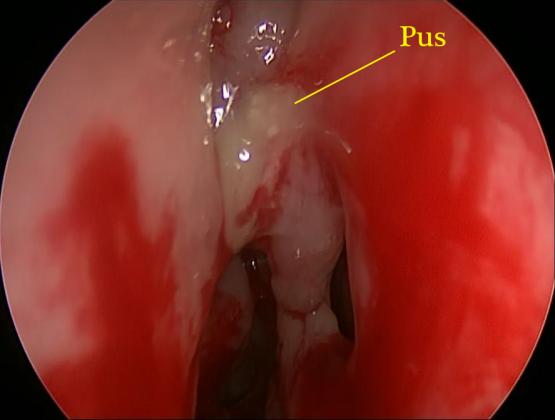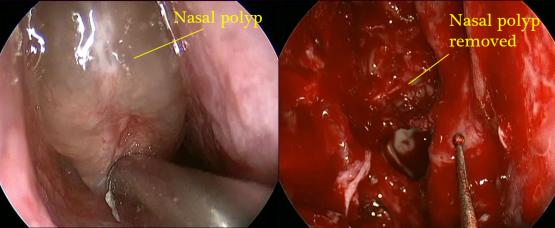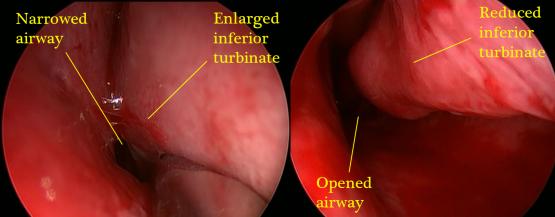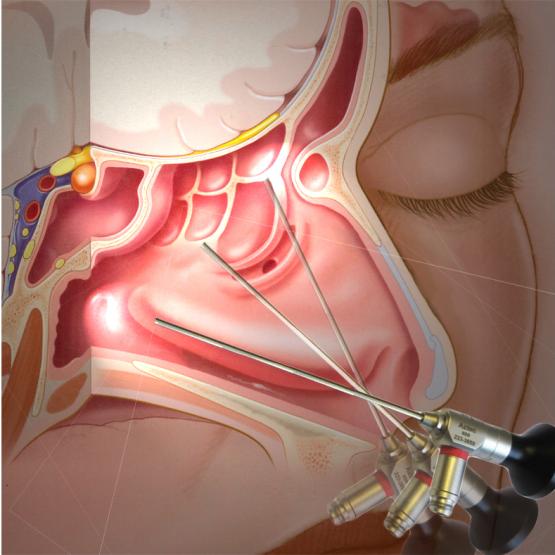What are paranasal sinuses?

The paranasal sinuses are air-filled extensions of the nasal cavity. The frontal sinuses (purple) are located in the forehead region, the ethmoid sinuses (blue) are located between the nasal septum and the eye and just below the brain, and the maxillary sinuses (green) are located in the cheek region below the eyes. The sphenoid sinuses (red) are located behind the ethmoid sinuses and are closely related to important anatomical structures such as the optic nerves that are required for vision, the pituitary gland, and the carotid arteries that carry blood to the brain.
The turbinates are normal outgrowths from either side of the nasal cavity that help regulate nasal air flow, temperature and humidification. Enlargement of the inferior or middle turbinates can obstruct one’s ability to breathe through the nose and can block the outflow of the contents of the paranasal sinuses, predisposing patients to infections.
The nasal septum separates the two nasal cavities, provides structural support for the nose, and influences airflow in the nasal cavity. A deviated or crooked septum can obstruct one’s ability to breathe through the nose, and can block the outflow of the contents of the paranasal sinuses, predisposing patients to infections.
What is sinusitis?
Sinusitis is a term that refers to inflammation of the paranasal sinuses, a major health problem in the United States that substantially affects up to 1 in 7 adults. The effects of sinusitis can be disabling in many respects, and have been shown to affect quality of life, productivity, & finances.
The cause of sinusitis can be infectious or noninfectious. Because the nose is almost always involved in inflammatory conditions of the sinuses, the term rhinosinusitis is sometimes used interchangeably with sinusitis.
Rhinosinusitis can be categorized in many different ways. One such way is by the duration of inflammation and symptoms:
- Acute rhinosinusitisis defined as up to 4 continuous weeks of purulent nasal drainage (containing pus) that occurs in the setting of nasal obstruction and/or facial pain or pressure. It is often preceded by an upper respiratory infection otherwise known as the common cold. Most infectious causes of rhinosinusitis are extensions of the viral infection causing the common cold; these typically resolve without medical intervention. However, a minority of these cases progress to bacterial rhinosinusitis and may require medical intervention. The symptoms may be similar for both viral and bacterial infections. Viral rhinosinusitis is suspected when symptoms have been present for less than 10 days and are not worsening. However, if symptoms last 10 days or longer after an upper respiratory infection, or worsen after an initial improvement within a 10-day period acute bacterial rhinosinusitis is suspected.
- Recurrent acute rhinosinusitis is defined as 4 or more episodes of acute sinusitis per year without signs or symptoms of infection between episodes.
- Subacute rhinosinusitis is defined as symptoms for more than 4 continuous weeks but less than 12 weeks
- Chronic rhinosinusitis is defined as 12 or more continuous weeks of two or more of the following symptoms:
- purulent (pus containing) nasal drainage
- nasal obstruction
- facial pain/pressure/fullness
- decreased sense of smell
In addition, to these symptoms, your doctor may see evidence of sinus or nasal inflammation, purulent (pus containing) mucus, or nasal polyps on examination or with imaging studies such as a CAT scan.
There are numerous causes of chronic rhinosinusitis including infectious (viral, bacterial, and fungal), allergic, anatomic, mucociliary (a problem with the natural clearance mechanism of the sinuses such as in cystic fibrosis or ciliary dyskinesia), and systemic disorders. Chronic rhinosinusitis is typically further subdivided into categories of patients with and without polyps.

What are the signs and symptoms of rhinosinusitis?
Patients with rhinosinusitis can have a combination of the following symptoms:
- Facial pain or pressure
- Nasal obstruction or blockage
- Nasal discharge or purulence (pus)
- Discolored postnasal discharge (dripping from the back of the nose)
- Hyposmia or anosmia (a reduced or absent sense of smell)
- Fevers
- Persistent sneezing or coughing
- Fatigue and irritability
- Headache
- Hoarseness
- Sore throat
- Bad breath or foul smell in the nose
- Tooth pain, tingling, or numbness
- Ear symptoms such as fullness, ringing or buzzing noise, or hearing loss
- Visual symptoms (double vision, pain with gaze, changes in vision)
What are nasal polyps?
Polyps are benign growths of the nose and sinuses that are characterized by swelling of the lining of the nasal cavity with an increase in cells that are responsible for inflammation and producing and secreting mucous. Although there are numerous theories as to what causes nasal polyps, we don’t yet fully understand these reasons.

What is a deviated nasal septum?
The nasal septum separates the two nasal cavities and influences nasal airflow. A deviated or crooked septum can obstruct one’s ability to breathe through the nose, and can block the outflow of the contents of the paranasal sinuses, predisposing patients to infections. A deviated nasal septum can be straightened surgically with a procedure called a septoplasty.

What is inferior turbinate hypertrophy?
Inferior turbinate hypertrophy refers to enlargement of the inferior turbinates, a condition that can obstruct one’s ability to breathe through the nose. Hypertrophy of the inferior turbinates can be addressed either with medications or surgically with a reduction of the turbinates.

How is rhinosinusitis diagnosed?
Rhinosinusitis is largely diagnosed based on the history and constellation of symptoms in addition to a physical exam. The physical exam should include internal examination of the nose and outflow regions of the sinuses with a rigid telescope or flexible fiberoptic scope that allows your doctor to examine your nasal cavity and sinuses. This can easily be performed in the office setting and reveals important information concerning mucosal (nasal lining) inflammation, anatomic deformities, possible masses, and the presence of mucus and purulence (pus).
Based on the history provided and the exam findings, your doctor may also order numerous laboratory bloodwork studies including immunological testing, imaging studies such as a computed tomography (CT) scan or a magnetic resonance imaging (MRI) study, cultures of nasal discharge (to determine the type of bacteria causing an infection), and allergy testing.
What are the treatment options for rhinosinusitis?
- Viral rhinosinusitis typically resolves without requiring medical intervention.
- Acute bacterial rhinosinusitis may be treated with antibiotics in addition to decongestants (to treat nasal obstruction), topical nasal steroids (to decrease inflammation), saline irrigation (to thin the nasal secretions, clean the sinonasal cavities, and stimulate the nasal cavity to clean itself), antihistamines (to decrease the effects of allergies), and mucolytics (to thin the thick nasal discharge). Surgical treatment is typically avoided, unless the patient is experiencing a major complication due to the acute bacterial rhinosinusitis.
- Chronic rhinosinusitis may be treated with longer courses of antibiotics, in addition to decongestants (to treat nasal obstruction), topical nasal steroids (to decrease inflammation), saline irrigation (to thin the nasal secretions, clean the sinonasal cavities, and stimulate the nasal cavity to clean itself), antihistamines (to decrease the effects of allergies), and mucolytics (to make thick nasal discharge thinner). Surgical treatment is considered if the patient is experiencing a complication due to the chronic bacterial rhinosinusitis, or is not improving with the medications listed above.
How is surgery performed for sinusitis?

Endoscopic sinus surgery is a minimally invasive surgical procedure to remove blockages of the sinuses for recurring or persistent sinus infections. The surgery does not require any external incisions and does not alter the appearance of your nose. The whole procedure is performed through the nostrils and almost all of the procedures are performed on an outpatient basis with patients going home the same day. During the procedure, a long thin rigid tube, called an endoscope, which has a light and a video camera, is inserted into the nose to visualize the inside of the nasal cavity and sinuses. This allows your surgeon to pass specialized surgical instruments through the nostrils to perform the surgery. In addition to opening up all of the affected sinuses, your surgeon may also address other issues at the same time, such as performing a septoplasty (to correct a deviated nasal septum), reducing the inferior turbinates (to allow for wider breathing passages) and removing polyps and other benign tumors, for example. Most patients experience a major relief in symptoms such as facial pain and swelling, difficulty breathing and headaches.

